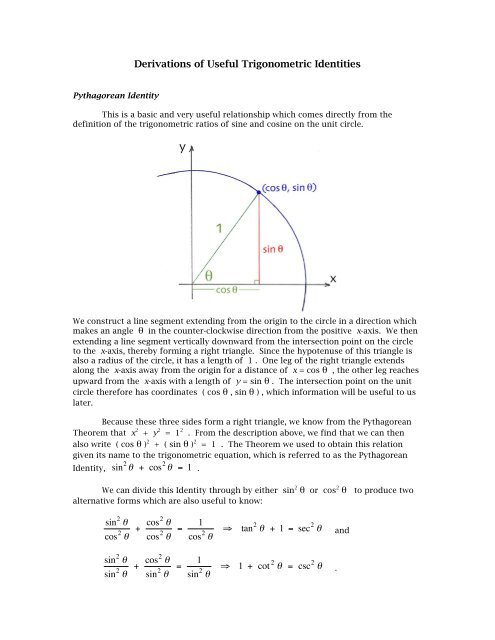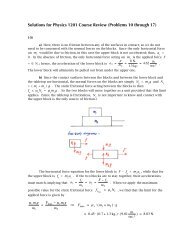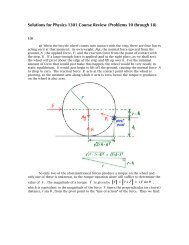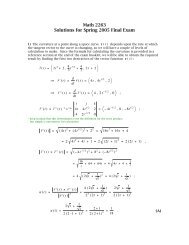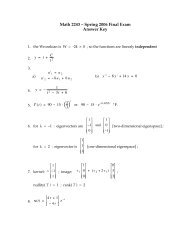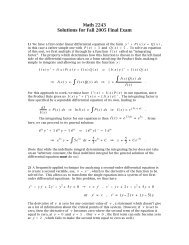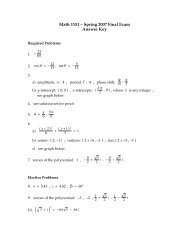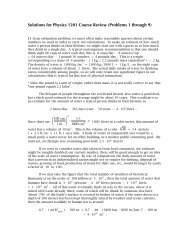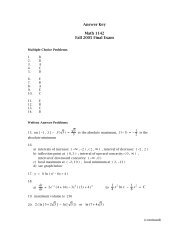Derivations of Useful Trigonometric Identities θ + cos θ = 1 θ θ θ θ θ ...
Derivations of Useful Trigonometric Identities θ + cos θ = 1 θ θ θ θ θ ...
Derivations of Useful Trigonometric Identities θ + cos θ = 1 θ θ θ θ θ ...
Create successful ePaper yourself
Turn your PDF publications into a flip-book with our unique Google optimized e-Paper software.
<strong>Derivations</strong> <strong>of</strong> <strong>Useful</strong> <strong>Trigonometric</strong> <strong>Identities</strong><br />
Pythagorean Identity<br />
This is a basic and very useful relationship which comes directly from the<br />
definition <strong>of</strong> the trigonometric ratios <strong>of</strong> sine and <strong>cos</strong>ine on the unit circle.<br />
We construct a line segment extending from the origin to the circle in a direction which<br />
makes an angle θ in the counter-clockwise direction from the positive x-axis. We then<br />
extending a line segment vertically downward from the intersection point on the circle<br />
to the x-axis, thereby forming a right triangle. Since the hypotenuse <strong>of</strong> this triangle is<br />
also a radius <strong>of</strong> the circle, it has a length <strong>of</strong> 1 . One leg <strong>of</strong> the right triangle extends<br />
along the x-axis away from the origin for a distance <strong>of</strong> x = <strong>cos</strong> θ , the other leg reaches<br />
upward from the x-axis with a length <strong>of</strong> y = sin θ . The intersection point on the unit<br />
circle therefore has coordinates ( <strong>cos</strong> θ , sin θ ) , which information will be useful to us<br />
later.<br />
Because these three sides form a right triangle, we know from the Pythagorean<br />
Theorem that x 2 + y 2 = 1 2 . From the description above, we find that we can then<br />
also write ( <strong>cos</strong> θ ) 2 + ( sin θ ) 2 = 1 . The Theorem we used to obtain this relation<br />
given its name to the trigonometric equation, which is referred to as the Pythagorean<br />
Identity, sin 2 θ + <strong>cos</strong> 2 θ = 1 .<br />
€<br />
We can divide this Identity through by either sin 2 θ or <strong>cos</strong> 2 θ to produce two<br />
alternative forms which are also useful to know:<br />
sin 2 θ<br />
<strong>cos</strong> 2 θ + <strong>cos</strong>2 θ<br />
<strong>cos</strong> 2 θ = 1<br />
<strong>cos</strong> 2 θ<br />
⇒ tan 2 θ + 1 = sec 2 θ and<br />
€<br />
sin 2 θ<br />
sin 2 θ + <strong>cos</strong>2 θ<br />
sin 2 θ = 1<br />
sin 2 θ<br />
⇒ 1 + cot 2 θ = csc 2 θ .<br />
€
Angle-addition Formulas<br />
Many trigonometric relationships are based on a key pair <strong>of</strong> equations referred<br />
to as the “angle-addition formulas”. These relations provide the means for calculating<br />
the sine or <strong>cos</strong>ine <strong>of</strong> the sum <strong>of</strong> two angles, in terms <strong>of</strong> the sines and <strong>cos</strong>ines <strong>of</strong> the<br />
individual angles.<br />
A useful construction as a starting point for developing these equations is to set<br />
up two line segments <strong>of</strong> length 1 , one making an angle α above the x-axis, the other<br />
at an angle β below that axis. Using the information discussed earlier, we can say that<br />
the right endpoint <strong>of</strong> the upper line segment lies at the coordinates ( <strong>cos</strong> α , sin α ) and<br />
that for the lower segment is at ( <strong>cos</strong> β , −sin β ) . The distance formula (which is also<br />
connected with the Pythagorean Theorem) gives the separation between these two<br />
points from<br />
d 2 = ( <strong>cos</strong>α − <strong>cos</strong> β ) 2 + ( sinα − [ − sin β ]) 2 = ( <strong>cos</strong>α − <strong>cos</strong> β ) 2 + ( sinα + sin β ) 2 .<br />
€<br />
We can now rotate this triangle, without changing its size or shape, so that the<br />
lower line segment lies on the x-axis, placing the right endpoint <strong>of</strong> that segment now at<br />
( 1, 0 ). At the origin, the vertex <strong>of</strong> the triangle there contains the angle we will<br />
represent as Φ = α + β . The opposite endpoint <strong>of</strong> the upper line segment now has
the coordinates ( <strong>cos</strong> Φ , sin Φ ) . The distance between the two endpoints <strong>of</strong> the line<br />
segments in this new situation is given by<br />
€<br />
d 2 = ( <strong>cos</strong> Φ − 1) 2 + ( sin Φ − 0) 2 .<br />
Since this is the same triangle, simply rotated in one diagram relative to the<br />
other, this distance is the same given by either equation, permitting us to write<br />
( <strong>cos</strong>α − <strong>cos</strong> β ) 2 + ( sinα + sin β ) 2 = ( <strong>cos</strong> Φ − 1) 2 + ( sin Φ − 0) 2<br />
€<br />
€<br />
⇒ (<strong>cos</strong> 2 α − 2 <strong>cos</strong> α <strong>cos</strong> β + <strong>cos</strong> 2 β ) + (sin 2 α + 2 sin α sin β + sin 2 β )<br />
= (<strong>cos</strong> 2 Φ − 2 <strong>cos</strong> Φ + 1) + sin 2 Φ<br />
⇒ <strong>cos</strong> 2 α + sin 2 α + <strong>cos</strong> 2 β + sin 2 β − 2 <strong>cos</strong> α <strong>cos</strong> β + 2 sin α sin β<br />
€<br />
= <strong>cos</strong> 2 Φ + sin 2 Φ − 2 <strong>cos</strong> Φ + 1<br />
€ ⇒ 1 + 1 − 2 <strong>cos</strong> α <strong>cos</strong> β + 2 sin α sin β = 1 − 2 <strong>cos</strong> Φ + 1<br />
applying the Pythagorean Identity<br />
€<br />
⇒ − 2 <strong>cos</strong> α <strong>cos</strong> β + 2 sin α sin β = − 2 <strong>cos</strong> Φ .<br />
€<br />
Recalling that Φ = α + β , we can at last write the angle-addition formula for <strong>cos</strong>ine,<br />
€<br />
<strong>cos</strong> (α + β ) = <strong>cos</strong> α <strong>cos</strong> β − sin α sin β .<br />
The construction we have discussed does not lend itself well to finding the<br />
corresponding angle-addition formula for sine. Instead we will use the Pythagorean<br />
Identity:<br />
€<br />
sin 2 Φ = 1 − <strong>cos</strong> 2 Φ = 1 − (<strong>cos</strong> α <strong>cos</strong> β − sin α sin β ) 2<br />
= 1 − (<strong>cos</strong> 2 α <strong>cos</strong> 2 β − 2 <strong>cos</strong> α <strong>cos</strong> β sin α sin β + sin 2 α sin 2 β ) <br />
€<br />
€<br />
€<br />
€<br />
€<br />
€<br />
= (sin 2 β + <strong>cos</strong> 2 β ) − <strong>cos</strong> 2 α <strong>cos</strong> 2 β + 2 <strong>cos</strong> α <strong>cos</strong> β sin α sin β − sin 2 α sin 2 β<br />
again using Pythagorean Identity; α could be used instead<br />
= sin 2 β − sin 2 α sin 2 β + <strong>cos</strong> 2 β − <strong>cos</strong> 2 α <strong>cos</strong> 2 β + 2 <strong>cos</strong> α <strong>cos</strong> β sin α sin β <br />
= sin 2 β (1 − sin 2 α ) + <strong>cos</strong> 2 β (1 − <strong>cos</strong> 2 α ) + 2 <strong>cos</strong> α <strong>cos</strong> β sin α sin β <br />
= sin 2 β <strong>cos</strong> 2 α + <strong>cos</strong> 2 β sin 2 α + 2 <strong>cos</strong> α <strong>cos</strong> β sin α sin β <br />
by the Pythagorean Identity<br />
= (sin β <strong>cos</strong> α + <strong>cos</strong> β sin α ) 2 .<br />
€
We are nearly finished: we still need to resolve signs, since taking the square root<br />
across this last equation leads to<br />
set β = 0 , this reduces to<br />
sin (α + β ) = ± (sin β <strong>cos</strong> α + <strong>cos</strong> β sin α ) . If we<br />
€<br />
sin (α + 0) = sin α = ± (sin 0 <strong>cos</strong> α + <strong>cos</strong> 0 sin α ) = ± (0 ⋅ <strong>cos</strong> α + 1 ⋅ sin α ) ,<br />
€<br />
which only yields a correct equation when using the plus sign; we find this is also the<br />
case if we set α = 0 . Hence, the angle-addition formula for sine is<br />
sin (α + β ) = sinα <strong>cos</strong> β + <strong>cos</strong>α sin β .<br />
From an angle-addition formula, we can produce an “angle-difference” formula<br />
by adding α to −β , rather than to +β . Because the <strong>cos</strong>ine function has even<br />
symmetry, € while the sine function has odd symmetry, the only effect this has on the<br />
original formula is to change the sign <strong>of</strong> the “ sin β “ factor (since sin( −β ) = −sin β ):<br />
<strong>cos</strong> (α − β ) = <strong>cos</strong> (α + [ − β ]) = <strong>cos</strong>α <strong>cos</strong> β − sinα sin[ − β ]<br />
= <strong>cos</strong>α <strong>cos</strong> β − sinα ⋅ (− sin β ) = <strong>cos</strong>α <strong>cos</strong> β + sinα sin β ;<br />
€<br />
sin (α − β ) = sin (α + [ − β ]) = sinα <strong>cos</strong> β + <strong>cos</strong>α sin[ − β ]<br />
€<br />
= sinα <strong>cos</strong> β + <strong>cos</strong>α ⋅ (− sin β ) = sinα <strong>cos</strong> β − <strong>cos</strong>α sin β .<br />
€<br />
Double-angle Formulas and Consequences<br />
€<br />
With the “angle-addition” formulas in hand, we can directly work out relations<br />
for multiples <strong>of</strong> an angle. Those which will be <strong>of</strong> the most frequent use to us are the<br />
formulas for “double-angles”:<br />
€<br />
€<br />
€<br />
€<br />
€<br />
€<br />
sin (α +α ) = sin (2α ) = sinα <strong>cos</strong>α + <strong>cos</strong>α sinα = 2 sinα <strong>cos</strong>α ;<br />
<strong>cos</strong> (α +α ) = <strong>cos</strong> (2α ) = <strong>cos</strong>α <strong>cos</strong>α − sinα sinα = <strong>cos</strong> 2 α − sin 2 α .<br />
The “double-angle formula” for <strong>cos</strong>ine can also be written in two alternative forms<br />
through the application <strong>of</strong> the Pythagorean Identity:<br />
<strong>cos</strong> (2α ) = (1 − sin 2 α ) − sin 2 α = 1 − 2 sin 2 α<br />
<strong>cos</strong> (2α ) = <strong>cos</strong> 2 α − (1 − <strong>cos</strong> 2 α ) = 2 <strong>cos</strong> 2 α − 1 .<br />
These latter two versions <strong>of</strong> the double-angle formula for <strong>cos</strong>ine can be<br />
re-arranged to yield two relations that will be helpful later on:<br />
€<br />
<strong>cos</strong> (2α ) = 1 − 2 sin 2 α ⇒ 2 sin 2 α = 1 − <strong>cos</strong> (2α )<br />
⇒ <strong>cos</strong> 2 α = 1 ⋅[1 + <strong>cos</strong> (2α ) ] .<br />
2<br />
€<br />
⇒ sin 2 α = 1 2 ⋅[1 − <strong>cos</strong> (2α ) ] and <br />
<strong>cos</strong> (2α ) = 2 <strong>cos</strong> 2 α − 1 ⇒ 2 <strong>cos</strong> 2 α = 1 + <strong>cos</strong> (2α )<br />
or
Product-to-sum formulas<br />
It will be <strong>of</strong> some use on certain occasions to know formulas for the product <strong>of</strong><br />
the sine or <strong>cos</strong>ine <strong>of</strong> one angle with the sine or <strong>cos</strong>ine <strong>of</strong> another. To derive these, we<br />
notice that such products appear in the angle-addition formulas, so we can add or<br />
subtract the equations in various ways to isolate the product in which we are interested.<br />
For example,<br />
+<br />
<strong>cos</strong> (α + β ) = <strong>cos</strong> α <strong>cos</strong> β − sin α sin β<br />
<strong>cos</strong> (α − β ) = <strong>cos</strong> α <strong>cos</strong> β + sin α sin β<br />
€<br />
€<br />
€<br />
€<br />
€<br />
=<br />
<strong>cos</strong> (α + β ) + <strong>cos</strong> (α − β ) = 2 <strong>cos</strong> α <strong>cos</strong> β<br />
⇒ <strong>cos</strong> α <strong>cos</strong> β = 1 2 [ <strong>cos</strong> (α − β ) + <strong>cos</strong> (α + β ) ] .<br />
The other products are obtained by using the combinations<br />
€<br />
€<br />
€<br />
−<br />
<strong>cos</strong> (α − β ) = <strong>cos</strong> α <strong>cos</strong> β + sin α sin β<br />
<strong>cos</strong> (α + β ) = <strong>cos</strong> α <strong>cos</strong> β − sin α sin β <br />
⇒ sin α sin β = 1 [ <strong>cos</strong> (α − β ) − <strong>cos</strong> (α + β ) ] ;<br />
2<br />
+<br />
sin (α + β ) = sinα <strong>cos</strong> β + <strong>cos</strong>α sin β<br />
sin (α − β ) = sinα <strong>cos</strong> β − <strong>cos</strong>α sin β .<br />
⇒ sin α <strong>cos</strong> β = 1 [ sin (α + β ) + sin (α − β ) ] ; and<br />
2<br />
€ sin (α + β ) = sinα <strong>cos</strong> β + <strong>cos</strong>α sin β<br />
− sin (α − β ) = sinα <strong>cos</strong> β − <strong>cos</strong>α sin β .<br />
€<br />
⇒ <strong>cos</strong> α sin β = 1 [ sin (α + β ) − sin (α − β ) ] .<br />
€<br />
2<br />
This last € formula can also be found by swapping the angles α and β in the equation<br />
for the product sin α <strong>cos</strong> β and using the odd symmetry <strong>of</strong> the sine function to write<br />
€ sin( β – α ) as −sin( α – β ).<br />
Sum-to-product formulas<br />
While we will not <strong>of</strong>ten need them, we should also know about the relations for the<br />
sums <strong>of</strong> sines and <strong>cos</strong>ines <strong>of</strong> two angles. These require a little work to derive, since we<br />
are essentially turning the product-to-sum formulas “inside-out”.<br />
(continued)
To accomplish this, we will re-label the angles in those formulas as θ and φ , so<br />
that θ + φ = α and θ – φ = β . By solving these little equations simultaneously, we<br />
have θ = α + β and φ = α − β . We can now re-write the product-to-sum<br />
2<br />
2<br />
formulas in this way:<br />
€<br />
1<br />
[ sin (θ + φ ) + sin (θ − φ ) ] = sin θ <strong>cos</strong> φ ⇒ sin (θ + φ ) + sin (θ − φ ) = 2 sin θ <strong>cos</strong> φ<br />
2<br />
€<br />
€<br />
⇒<br />
⎛⎛<br />
sin α + sin β = 2 sin α + β ⎞⎞ ⎛⎛<br />
⎜⎜ ⎟⎟ <strong>cos</strong> α − β ⎞⎞<br />
⎜⎜ ⎟⎟ ;<br />
⎝⎝ 2 ⎠⎠ ⎝⎝ 2 ⎠⎠<br />
1<br />
⎛⎛ α + β ⎞⎞ ⎛⎛<br />
[ sin (θ + φ ) − sin (θ − φ ) ] = <strong>cos</strong> θ sin φ ⇒ sin α − sin β = 2 <strong>cos</strong> ⎜⎜ ⎟⎟ sin α − β ⎞⎞<br />
⎜⎜ ⎟⎟ ;<br />
2 ⎝⎝ 2 ⎠⎠ ⎝⎝ 2 ⎠⎠<br />
€<br />
This can also be obtained by replacing β with −β in the preceding sum-to-product formula and using the<br />
odd symmetry <strong>of</strong> the sine function to write sin( −β ) = −sin β .<br />
1<br />
2<br />
⎛⎛ α + β ⎞⎞ ⎛⎛<br />
[ <strong>cos</strong> (θ − φ ) + <strong>cos</strong> (θ + φ ) ] = <strong>cos</strong> θ <strong>cos</strong> φ ⇒ <strong>cos</strong> α + <strong>cos</strong> β = 2 <strong>cos</strong> ⎜⎜ ⎟⎟ <strong>cos</strong> α − β ⎞⎞<br />
⎜⎜ ⎟⎟ ;<br />
⎝⎝ 2 ⎠⎠ ⎝⎝ 2 ⎠⎠<br />
and (this one requires a bit <strong>of</strong> extra work)<br />
€<br />
1<br />
[ <strong>cos</strong> (θ − φ ) − <strong>cos</strong> (θ + φ ) ] = sin θ sin φ<br />
2<br />
⇒ <strong>cos</strong> (θ + φ ) − <strong>cos</strong> (θ − φ ) = − 2 sin θ sin φ<br />
switching the order <strong>of</strong> terms<br />
€<br />
⇒<br />
⎛⎛<br />
<strong>cos</strong> α − <strong>cos</strong> β = − 2 sin α + β ⎞⎞ ⎛⎛<br />
⎜⎜ ⎟⎟ sin α − β ⎞⎞<br />
⎜⎜ ⎟⎟ .<br />
⎝⎝ 2 ⎠⎠ ⎝⎝ 2 <br />
⎠⎠<br />
€<br />
-- G. Ruffa<br />
3 – 9 June 2010


